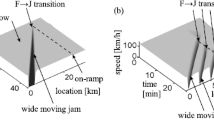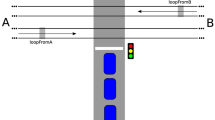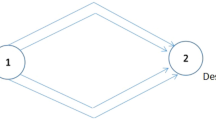Abstract
The steady-state traffic flow on a simply circled road network is analytically studied using the Lighthill-Witham-Richards (LWR) model. The network is typically composed of a diverging and a merging junction together with three connected road sections. At the diverging junction, traffic flow is assigned to satisfy the user-equilibrium condition. At the merging junction, queuing or shock structures due to the bottleneck effect is taken into account. We indicate that the solution depends on the total number of vehicles on the road network, and that the bottleneck effect gives rise to not only capacity drop but inefficient utilization of the two road sections upstream the merging junction. To further validate the derived steady-state solution, a first-order Godunov scheme of the LWR model is adopted for simulation of traffic flow in each road section and the demand-supply concept is applied to provide boundary values at the junctions for the scheme. By varying the total number of vehicles from zero to the maximum, the simulation shows that a randomly distributed state of traffic flow is bound to evolve into a steady state, which is completely in agreement with the analytical solution.
Similar content being viewed by others
References
LeVeque R. J. Finite volume methods for hyperbolic problems [M]. Cambridge, UK: Cambridge University Press, 2002.
Jin W. L., Zhang H. M. The inhomogeneous kinematic wave traffic flow model as a resonant nonlinear system [J]. Transportation Science, 2003, 37(3): 294–311.
Zhang P., Liu R. X. Hyperbolic conservation laws with space-dependent flux: I Characteristics theory and Riemann problem [J]. Journal of Computational and Applied Mathematics, 2003, 156(1): 1–21.
Zhang P., Wong S. C., Xu Z. L. A hybrid scheme for solving a multi-class traffic flow model with complex wave breaking [J]. Computer Methods in Applied Mechanics Engineering, 2008, 197(45–48): 3816–3827.
Qiao D. L., Zhang P., Lin Z. Y., Wong S. C., Choi K. A Runge-Kutta discontinuous Galerkin scheme for hyperbolic conservation laws with discontinuous fluxes [J]. Applied Mathematics and Computation, 2017, 292: 309–319.
Garavello M., Natalini R., Piccoli B. et al. Conservation laws with discontinuous flux [J]. Networks and Heterogenous Media, 2007, 2(1): 159–179.
Bliemer M. C. J., Raadsen M. P. H., Mannering F. Static traffic assignment with residual queues and spillback [J]. Transportation Research Part B: Methodological, 2020, 132: 303–319.
Cheng Q., Liu Z., Szeto W. Y. A cell-based dynamic congestion pricing scheme considering travel distance and time delay [J]. Transportmetrica B: Transport Dynamics, 2019, 7(1): 1286–1304.
Coclite G. M., Garavello M., Piccoli B. Traffic flow on a road network [J]. SIAM Journal on Mathematical Analysis, 2005, 36(6): 1862–1886.
Lin Z. Y., Zhang P., Dong L. Y. et al. Traffic flow on a road network using a conserved higher-order model [J]. AIP Conference Proceedings, 2015, 1648(1): 530006.
Lighthill M. J., Whitham G. B. On kinematic waves: II. A theory of traffic flow on long crowded roads [J]. Proceedings of the Royal Society of London, Series A, Mathematical and Physical Sciences, 1955, 229(1178): 317–345.
Richards P. I. Shockwaves on the highway [J]. Operation Research, 1956, 4(1): 42–51.
Wong W., Wong S. C. Network topological effects on the macroscopic Bureau of Public Roads function [J]. Transportmetrica A: Transport Science, 2016, 12(3): 272–296.
Jayakrishnan R., Tsai W. K., Chen A. A dynamic traffic assignment model with traffic-flow relationships [J]. Transportation Research Part C: Emerging Technologies, 1995, 3(1): 51–72.
Saw K., Katti B. K., Joshi G. Literature review of traffic assignment: static and dynamic [J]. International Journal of Transportation Engineering, 2015, 2(4): 339–347.
Wei Y. F., Guo S. L., Xue Y. Empirical verification of anisotropic hydrodynamic traffic model in traffic analysis at intersections in urban area [J]. Journal of Hydrodynamics, 2007, 19(2): 230–235.
Jin W. L. On the existence of stationary states in general road networks [J]. Transportation Research Part B: Methodological, 2015, 81: 917–929.
Jin W. L. On the stability of stationary states in general road networks [J]. Transportation Research Part B: Methodological, 2017, 98: 42–61.
Wu C. X., Zhang P., Wong S. C. et al. Steady-state traffic flow on a ring road with up- and down-slopes [J]. Physica A, 2014, 403: 85–93.
Toro E. F. Riemann solvers and numerical methods for fluid dynamics [M]. Berlin Heidelberg, Germany: Springer-Verlay, 1999.
Zhang J., Qu X., Wang S. A. Reproducible generation of experimental data sample for calibrating traffic flow fundamental diagram [J]. Transportation Research Part A: Policy and Practice, 2018, 111: 41–52.
Qu X., Zhang J., Wang S. On the stochastic fundamental diagram for freeway traffic: Model development, analytical properties, validation, and extensive applications [J]. Transportation Research Part B: Methodological, 2017, 104: 256–271.
Qu X., Wang S., Zhang J. On the fundamental diagram for freeway traffic: A novel calibration approach for singleregime models [J]. Transportation Research Part B: Methodological, 2015, 73: 91–102.
Acknowledgements
This work was supported by the China Postdoctoral Science Foundation (Grant No. 2019M661362), the Opening Research Fund of National Engineering Laboratory for Surface Transportation Weather Impacts Prevention (Grant No. NEL-2019-02).
Author information
Authors and Affiliations
Corresponding author
Additional information
Projects supported by the National Natural Science Foundation of China (Grant Nos. 11972121, 11672348), the National Key Research Development Program of China (Grant No. 2018YFB1600900).
Biography
Yu-pei Lyu (1978-), Female, Ph. D., E-mail: peipei@zjhu.edu.cn
Rights and permissions
About this article
Cite this article
Lyu, Yp., Guo, Mm., Zhang, P. et al. Steady-state solution of traffic flow on a simple road network. J Hydrodyn 33, 950–957 (2021). https://doi.org/10.1007/s42241-021-0084-y
Received:
Revised:
Accepted:
Published:
Issue Date:
DOI: https://doi.org/10.1007/s42241-021-0084-y




